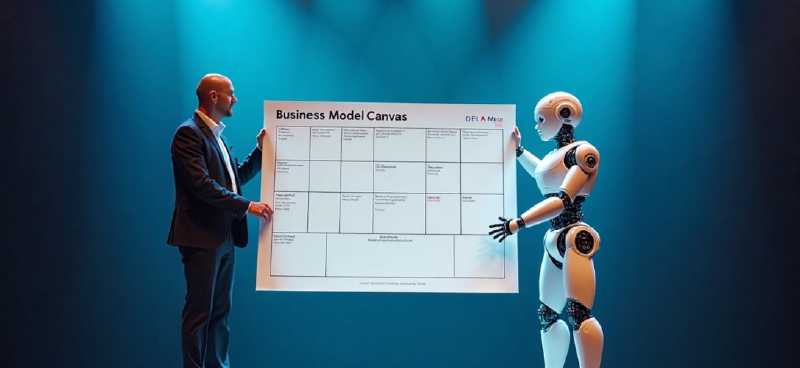
A Blueprint for Human-Guided AI Strategy

A Blueprint for Human-Guided AI Strategy
Introduction: The Strategic Imperative of AI
Every established company today faces the same pressing question: “We have access to AI, but how do we actually use it to build something valuable and strategic?”
The temptation is to seek automation, to hand over the complex task of strategy formulation to an AI agent and await a perfect, polished answer. This approach, however, misunderstands the fundamental nature of both strategy and artificial intelligence. Strategy is not a destination; it’s a journey of deliberate choices, trade-offs, and nuanced adjustments. It cannot be automated because it is inherently human.
The true power of AI lies not in replacing this crucial human judgment, but in accelerating it. The quality of an AI-generated business model is not a reflection of the AI’s intelligence, but a direct result of the user’s own depth of understanding, carefully guided and challenged at every step.
We recently put this principle to the test, conducting an experiment to build a business model canvas using two AI tools and two methodologies. The results were revealing, confirming a core tenet of our philosophy: the path to AI mastery is through a process of guided iteration. This is where strategy truly comes to life.
Two Tools - Two Approaches
To truly understand the role of AI in strategy, we must move from theory to practice. We designed a controlled experiment to build a business model canvas for a specific core customer: Hotel General Managers of international brands in Asia. The goal was identical, but the methodologies were fundamentally different.
Approach 1: The Guided Prompt Chain (Using Deepseek V3.1)
This method treated the AI as a dedicated consultant. We engaged in a structured, sequential dialogue, where each prompt built upon the last, requiring a critical business decision before proceeding.
- The Process: It began with a foundational prompt to analyze and prioritize the customer’s pain points. The AI didn’t just list them; it provided a “Big Four” style memo with rigorous analysis, ranking them by strategic value and explaining the cascading impact of, for instance, staff retention on operational costs and guest satisfaction.
- The Key Differentiator: At each step, from generating business ideas to selecting revenue models, the process asked relevant questions in context. The user could digest the analysis easily, make an informed choice, and then instruct the AI on the next step. This mirrors a real-world consulting engagement, where an expert provides options and context, but the client owns the final decision. The AI’s role was to augment human decision-making with deep analysis, not to automate it away.
Approach 2: The Autonomous AI Agent (Using Anygen)
This method treated the AI as an efficient facilitator. We gave a single, overarching instruction to an agent programmed to execute a multi-step process autonomously.
- The Process: The agent took immediate control, presenting a series of forms to capture information about the core customer, pain points, and capabilities. It was designed for efficiency, streamlining data collection through dropdowns and pre-defined options to quickly reach an output.
- The Key Differentiator: The experience was transactional. The agent’s primary goal was to complete the steps in its script and fill the boxes of the business model canvas. While highly structured and user-friendly, the process did not general the same deep, reflective analysis that the prompt chain elicited. The user was more of an information provider than a strategic decider.
On the surface, both methods arrived at a destination: a comprehensive business model. But as any seasoned leader knows, the value isn’t just in the final document, it’s in the strategic thinking forged during the journey to create it. The critical differences emerged not in the what, but in the how.
The Journey, Not Just the Destination
At a glance, the outcome of our experiment might seem paradoxical. Both AI approaches, the guided consultant and the autonomous agent, produced a good business model canvas. Both were comprehensive, logically sound, and many of their final recommendations were surprisingly similar. So, does the tool or method even matter?
Absolutely. The critical difference wasn’t in the final output, but in the strategic journey taken to get there. This is where the fundamental truth of AI-powered strategy is revealed: the value is forged in the iterative process of choice and adjustment, not in the passive reception of an answer.
The guided prompt chain forced a discipline of strategic thinking. Each prompt required a decision. Each decision created a branch in the strategic pathway. This mirrors reality. Strategy is not a multiple-choice test with one right answer; it is a series of deliberate, conscious choices about what to do and, crucially, what not to do.
The AI in this model excelled not by being an oracle, but by being an expert sparring partner. It augmented the process in three key ways:
- Providing Context and Framing: It didn’t just list pain points; it ranked them by impact and explained the cascading effects of staff retention on costs and guest satisfaction, educating the user and deepening their own understanding.
- Asking “Why”?: By offering multiple, viable options for internal capabilities, it acted like a seasoned consultant probing a client’s assumptions. This pushed the user to think critically about their own strengths and how they truly align with the market need, rather than just selecting from a predefined list.
- Building a Narrative: Each step logically followed the last, creating a coherent story for the business model. The value propositions naturally evolved from the chosen pain point, and the revenue models were a direct consequence of the selected products. This creates a defensible, understandable strategy, not just a completed template.
The autonomous agent, while efficient, primarily focused on completing a task. The guided consultant focused on building understanding. One gives you a fish; the other teaches you to fish and provides a detailed analysis of the local aquatic ecosystem, optimal fishing techniques, and a forecast of market prices for your catch.
This distinction is the very heart of effective AI integration. It’s not about offloading thinking; it’s about accelerating and enhancing it. The final business model is merely the artifact—the real value is the strategic clarity and confidence gained throughout the process.
Deconstructing the Differences
While both approaches culminated in a business model canvas, a side-by-side comparison reveals profound differences in depth, strategic rigor, and ultimate utility. The final canvases were not equals; one was a static report, the other a dynamic strategic asset.
Here is a breakdown of the key divergences:
| Feature | Guided Prompt Chain (Consultant Model) | Autonomous Agent (Facilitator Model) | Why It Matters |
|---|---|---|---|
| Strategic Foundation | Built on a prioritized list of pain points, with a clear, justified ranking (#1: Retain Staff -> #2: Lower Costs). Value propositions are directly tied to tackling these core issues. | Pain points are collected but not rigorously weighted. The strategic “why” behind the prioritization is missing, making the model feel more generic. | Strategy is about focus. The guided model forces you to bet on the most valuable problems to solve, creating a clear investment thesis. |
| Value Proposition | Detailed, benefit-rich, and specific. e.g., “Reduce voluntary turnover by identifying root causes of dissatisfaction,” and “Boost morale through intelligent scheduling.” | More functional and feature-led. e.g., “Multilingual frontline engagement service.” Focuses on what it is rather than why it matters. | A compelling value proposition is the heart of any business model. The guided model articulates a stronger, more emotionally resonant market offer. |
| Key Resources & Activities | Distinct and strategically aligned. Resources like “AI training algorithms” directly enable Activities like “AI-powered content curation.” The logic is clear and interconnected. | More blended and less specific. Activities and Resources are described but lack the same crisp, cause-and-effect relationship. | This clarity is crucial for execution. It tells you exactly what capabilities to build and what actions to take to deliver on your value promise. |
| Customer Relationships | Strategic and high-touch. “Dedicated success managers” and “Quarterly strategic business reviews” indicate a deep, advisory partnership aimed at long-term transformation. | Implied but not defined. The model assumes a relationship but doesn’t specify its nature, leaning towards a more transactional “service provider” dynamic. | For complex B2B sales, the relationship model is a key differentiator. The guided model promises a higher level of partnership and client success. |
| Cost Structure | Tied to strategic investments. Costs are linked to building and maintaining core differentiators: “Platform development & AI training,” “Content creation & expert partnerships.” | Operationally focused. Lists costs like “Platform hosting” and “Support team” which, while accurate, are not the primary strategic investments. | Understanding your strategic cost drivers is essential for smart budgeting and scaling. The guided model highlights the costs that truly create value. |
The Verdict:
The Autonomous Agent produced a valid, logically consistent business plan outline. It efficiently gathered information and placed it in the right boxes. It is a useful starting point.
The Guided Prompt Chain, however, generated a strategic narrative. It didn’t just fill a template; it built a compelling, justified story about how a business creates, delivers, and captures value. The canvas it produced is not just a description of a business; it is a tool for debating, validating, and communicating its core strategy.
This distinction is critical for established companies. You are not building a startup from a blank slate; you are integrating AI into a complex existing operation. The strategic depth, clarity, and justified prioritization offered by the guided, iterative process are not luxuries—they are prerequisites for successful transformation. The final model isn’t just a destination; it’s a map that explains the terrain you’ve just navigated.
The Human in the Loop: Why Guidance is The Differentiator
The comparison of the two canvases reveals a truth that transcends this experiment: the slightly superior output was not a function of a “smarter” AI, but of a smarter process. The Guided Prompt Chain triumphed because it was architected around a core principle we champion at System in Motion: strategic acceleration.
This approach leverages AI’s unparalleled ability to process information, generate options, and provide analysis, while reserving the most critical element for human intelligence: judgment.
The autonomous agent followed a script. The guided consultant, however, demonstrated the behaviors of a true strategic partner:
- It Educated and Challenged: By adding common industry pain points and asking for prioritization, it didn’t just take instructions—it expanded the user’s perspective. By offering multiple strong choices for internal capabilities, it acted like a consultant asking, “Have you considered this?” This forces a deeper level of strategic thinking that a simple form cannot.
- It Forced Ownership and Clarity: Every pause for a decision was a moment of accountability. The user couldn’t passively proceed; they had to articulate a choice and, in doing so, solidify their own understanding and commitment to a strategic direction. This transforms the canvas from an academic exercise into a reflection of the leadership team’s concrete decisions.
- It Built a Coherent Narrative: The logical flow from pain point -> business idea -> product -> revenue model created a story. Each element logically supported the next, resulting in a business model that is defensible, understandable, and easy to communicate to stakeholders. The agent’s canvas, while complete, felt more like a collection of related data points than a woven strategic narrative.
This “human-in-the-loop” methodology is the differentiator between a generic output and a tailored, high-value strategic asset. It aligns perfectly with our brand values of Quality, Trust, and Clarity. The quality of the final model is a direct result of the quality of the iterative process. Trust is built through transparency and education, not black-box automation. Clarity is achieved through constant refinement and justification of choices.
The Path to True AI Mastery
The central lesson from this experiment is not which AI model to use, but how to think about using AI. For established companies, the goal is not to find a tool that does the thinking for you, but to find a partner that provides the framework, discipline, and expert guidance to do your best thinking.
This is the essence of AI mastery. It’s the difference between:
- Automation: Having an AI fill out a template.
- Augmentation: Using an AI to challenge your assumptions, expand your perspective, and pressure-test your strategy.
The guided, iterative process is a powerful metaphor for successful AI integration itself. It’s not a one-time event where you plug in a tool and get an answer. It is a continuous cycle of input, analysis, choice, and adjustment. This is how you move from theoretical potential to tangible business outcomes.
The future of AI in business belongs not to those who automate the fastest, but to those who learn how to leverage it most strategically. It’s about empowering your team to ask better questions, navigate complex choices, and own the strategy that will define your future.
We are Here to Empower
At System in Motion, we are on a mission to empower as many knowledge workers as possible. To start or continue your GenAI journey.
You should also read


AI Data Scientist: Success Isn't Guaranteed
Article 8 minutes readLet's start and accelerate your digitalization
One step at a time, we can start your AI journey today, by building the foundation of your future performance.
Book a Training